Thermal detectors
CHAPTER 07
1 Thermopile detectors
1-1 Features
1-2 Structure
1-3 Characteristics
1-4 How to use
1-5 New approaches
1-6 Applications
2 Bolometers
2-1 Operating principle and structure
2-2
Characteristics
1
�
Thermal detectors
Thermal detectors have an absorption layer that absorbs and converts light into heat, and provide an electric signal output that
represents the change in absorption layer temperature. Because thermal detectors have no wavelength dependence, they can
serve as infrared detectors when used with a window material such as Si that transmits infrared light.
Thermal detectors are mainly classified into: (1) thermopile detectors that change in electromotive force, (2) bolometers that
change in resistance, (3) pyroelectric detectors that change in dielectric surface charge, and (4) diodes that change in voltage-
current characteristics. Hamamatsu manufactures two types of thermal detectors: thermopile detectors and bolometers. These
two types of thermal detectors are different in terms of operating principle, structure, and characteristics.
Thermopile detectors have a structure in which a large number of thermocouples are serially connected on a silicon substrate
and their sensitivity increases as more thermocouples are used. This means that the larger the photosensitive area, the higher
the sensitivity, because the number of thermocouples is proportional to the size of the photosensitive area.
In bolometers, the photosensitive area uses a bolometer resistance made up of thermoelectric conversion materials, so the
resistance temperature coefficient is the primary cause in determining bolometer sensitivity. Since bolometer sensitivity does
not depend on the size of the photosensitive area, detectors can be fabricated that have a small photosensitive area yet no drop
in sensitivity.
Thermopile detectors are usually manufactured as single-element detectors with an ample photosensitive area or arrays with
a small number of elements, while bolometers are manufactured as arrays with a larger number of elements than thermopile
detectors.
Hamamatsu thermopile detectors and bolometers
Product name
Multi-element array
Sensitivity
enhancement
Supply current
Package
atmosphere
Rise time
Thermopile detector
Possible with larger pixel size
(pixel size: 200 × 200 µm or larger)
Possible
Not required
(thermal
electromotive force)
Nitrogen
1 ms or more
Bolometer
Possible with smaller pixel size
(pixel size: 75 × 75 µm or smaller)
Possible
Required
Vacuum
2 ms or more
2
�
1.
Thermopile detectors
[Figure 1-1] Thermally isolated structure
(thermopile detector)
Thermocouple
Hot
junction
Metal A
Metal B
T
Δ
ΔV
Cold
junction
Hot
junction
T
Δ
Cold
junction
n × ΔV
Our thermopile detector structures differ according to the
type of device, namely, single/dual/quad element types
and linear/area arrays.
KIRDC0046EA
Single/dual/quad element types
Single/dual/quad element types have large photosensitive
areas and are manufactured by bulk processing technology
with high workability. Etching is performed from the
backside of the substrate to form the photosensitive area
in a membrane state so that the hot and cold junctions
are thermally isolated from each other to achieve high
sensitivity.
[Figure 1-2] Cross-sectional view
(single/dual/quad element types)
Cold junction
Photosensitive area
Infrared
absorption film
Hot junction
Thermocouple
Isolation
layer
Substrate
KIRDC0106EA
Thermopile detectors are thermal detectors that utilize
the Seebeck effect in which a thermal electromotive
force is generated in proportion to the incident infrared
light energy. Thermopile detectors themselves have no
wavelength dependence and so are used with various
types of window materials for diverse applications such as
temperature measurement, human body sensing, and gas
analysis.
1 - 1
Features
Operates at room temperature
Spectral response characteristics that are not
dependent on wavelength
No optical chopping is required, and voltage output
can be obtained according to input energy.
Low cost
Long life
1 - 2
Structure
In order to obtain a large output voltage, Hamamatsu
thermopile detectors have many thermocouples that
are serially connected on a silicon substrate to magnify
the temperature difference between the hot and cold
junctions. The hot junction side (photosensitive area) is
designed to be a thermally isolated structure on which
an infrared absorption film is attached. To make the
thermally isolated structure, MEMS technology is used
to process the membrane (thin film) to make it float in a
hollow space. Our thermopile detectors use materials that
have a large Seebeck coefficient (thermal electromotive
force) and are easily formed by the semiconductor
process.
When infrared light enters a thermopile detector having
the above mentioned structure, the hot junction on
the membrane heats up and produces a temperature
difference (ΔT) between the hot and cold junctions
accompanied by generation of a thermal electromotive
force (ΔV).
[Table 1-1] Hamamatsu thermopile detectors
Type
Number of elements Window material
Spectral response range
Package
Main applications
Single element
Dual element
Quad element
Linear array
Area array
1
2
4
16, 32
8 × 8
Anti-reflection coated Si
3 to 5 µm
TO-18
Gas analysis, temperature measurement
Band-pass filter
3.9 µm, 4.3 µm
3 to 5 µm
TO-5
TO-8
Gas analysis
5 µm long-pass filter
5 to 14 µm
Flat package
Temperature measurement
TO-8
Temperature measurement, human body sensing
3
�
Linear and area arrays
Temperature characteristics
[Figure 1-4] Temperature characteristics of sensitivity
(single element type T11262-01, typical example)
60
)
W
/
V
(
y
t
i
v
i
t
i
s
n
e
S
58
56
54
52
50
48
46
44
42
40
-20
-10
0
10
20
30
40
50
60
70
80
Element temperature (°C)
KIRDB0522EA
[Figure 1-5] Temperature characteristics of element
resistance (T11262-01, typical example)
150
140
130
120
110
)
Ω
k
(
e
c
n
a
t
s
i
s
e
r
t
n
e
m
e
E
l
100
-20
-10
0
10
20
30
40
50
60
70
80
Element temperature (°C)
KIRDB0523EA
Linearity
Figure 1-6 shows an example of the relation between the
input energy and output voltage. Thermopile detector
output voltage is proportional to the input energy.
To manufacture linear and area arrays, the gap between
each element must be made narrow in order to reduce
non-sensitive areas. To do this, the portion directly under
each photosensitive area is selectively bored by surface
processing technology so that the photosensitive area
becomes a thin membrane-like structure. CMOS process
technology is utilized to lay out the signal processing
circuits on the same chip where the thermopile section is
formed.
[Figure 1-3] Cross-sectional view
(linear and area arrays)
Thermocouple
Cold junction
Hot
junction
Infrared
absorption film
Isolation
layer
Etching
hole
Metal
wiring
Substrate
Thermopile section
Thermopile section
Signal processing
circuit
KIRDC0107EA
1 - 3
Characteristics
Sensitivity
Thermopile sensitivity (Rv) is determined by the number
of thermocouples as expressed by equation (1).
η n α
Rv = [V/W] ……… (1)
G 1 + ω2τ2
η : emissivity
n : number of thermocouples
α : Seebeck coefficient
G : thermal conductivity
ω : angular frequency
τ : thermal time constant
Noise
Thermal noise called Johnson noise in the element
resistance is predominant in thermopile detector noise.
Noise (VN) is expressed by equation (2).
VN = 4k T Rd Δf [V rms] ……… (2)
k : Boltzmann’s constant
T : absolute temperature
Rd : element resistance
Δf : bandwidth
4
�
[Figure 1-6] Output voltage vs. input energy
(T11262-01, typical example)
(Ta=25 ˚C)
10-1
10-2
10-3
10-4
10-5
)
V
(
e
g
a
t
l
o
v
t
u
p
t
u
O
10-6
10-5
10-4
10-3
10-2
10-1
Input energy (W/cm2)
KIRDB0560EA
[Figure 1-7] Frequency characteristics
)
B
d
(
t
u
p
t
u
o
e
v
l
i
t
a
e
R
2
1
0
-1
-2
-3
-4
-5
0.1
(Typ. Ta=25 ˚C)
0.25 × 0.25 mm
0.3 × 0.3 mm
2 × 2 mm
1.2 × 1.2 mm
1
10
100
1000
Frequency (Hz)
KIRDB0561EA
Frequency characteristics
Spectral response
Figure 1-7 shows the frequency characteristics of thermopile
detectors each having a different photosensitive area.
Frequency response tends to decrease as the photosensitive
area becomes larger.
Since thermopile detectors have no wavelength dependence,
their spectral response is determined by the transmittance
characteristics of window materials. Spectral transmittance
characteristics of typical window materials are shown in
Figure 1-8.
1 - 4
How to use
Single/dual/quad element types
(1) Circuit not using thermistor
In cases where the ambient temperature is constant or
high precision measurement is not required, thermopile
detectors can be used with a circuit that does not include
a thermistor.
[Figure 1-8] Spectral transmittance characteristics of window materials
)
%
(
e
c
n
a
t
t
i
m
s
n
a
r
T
100
90
80
70
60
50
40
30
20
10
0
2.5
Anti-reflection coated Si
T11262-01
5 μm long-pass filter
8 to 14 μm band-pass filter
3.9 μm band-pass filter
T11722-01 (reference light)
Si
4.3 μm band-pass filter
T11722-01 (CO2)
4.4 μm band-pass filter
5
7.5
10
12.5
15
17.5
20
22.5
25
Wavelength (μm)
KIRDB0512EA
5
�
Dual-polarity power supply type
[Figure 1-9] Amplifier circuit
(dual-polarity power supply type)
method using a microcontroller is more common.
Figure 1-11 shows a circuit example where the thermistor
output signal is fed into the amplifier circuit. This type of
circuit is used when high measurement accuracy is not
required. The circuit shown in Figure 1-11 applies to both
cases where the thermistor is externally connected to the
thermopile detector or the thermistor is built into the
thermopile detector.
[Figure 1-11] Amplifier circuit with thermistor
Vout
+V
Thermopile
detector
Thermistor
Rth
Rd
Ra
Rb
Rc
6
Vout
+V
3
2
7
+
-
4
-V
R2
C1
R1
Gain = 1 + (R2/R1)
fhigh = 1/(2πR2 C1)
Vth
KIRDC0051EB
Finding the resistance values (Ra, Rb, Rc, Rd) for the
circuit with a thermistor
To find the resistance value of Rd at which the thermistor
output Vth is linear in the operating temperature range
1) Determine the operating temperature range (Tmin to Tmax).
2) Find the resistance value (Rh) of the thermistor Rth at Tmax.
3) Find the resistance value (Rl) of the thermistor Rth at Tmin.
4) Find the resistance value (Rm) of the thermistor Rth at
an intermediate temperature between Tmin and Tmax.
5) Find the resistance value of Rd from equation (3).
Rh Rm + Rl Rm - 2Rh Rl
Rd = ……… (3)
Rh + Rl - 2Rm
To measure the thermopile output voltage Vout and
check the voltage range where the thermistor output
voltage (Vth) varies in the operating temperature range
(when the measurement object's temperature is 25 °C)
1) Measure the thermopile detector output voltage
(Voutmin) at Tmax.
2) Measure the thermopile detector output voltage
(Voutmax) at Tmin.
C1
R2
6
-V
2
3
-
+
4
7
+V
R1
Thermopile detector
Gain = 1 + (R2/R1)
fhigh = 1/(2πC1 R2)
KIRDC0049EA
Single power supply type
When using an op amp that operates from a single power
supply, an error occurs near ground potential which is
caused by the op amp’s offset voltage and nonlinearity. To
cope with this, the thermopile detector is operated with
one terminal biased. In the circuit shown in Figure 1-10,
the op amp supply voltage is biased with dividing resistors
R3 and R4.
[Figure 1-10] Amplifier circuit
(single power supply type)
C1
R2
GND
4
7
2
3
-
+
+V
R1
Thermopile detector
6
Vout
Gain = 1 + (R2/R1)
fhigh = 1/(2πC1 R2)
+V
R3
R4
KIRDC0050EB
To find the resistance values of Ra, Rb and Rc
(2) Circuit using thermistor
Output signals of a thermopile detector are temperature
dependent. When detecting the temperature of an object
in locations where the thermopile element temperature
may drastically fluctuate, some means of making the output
signals constant is required to ensure stable temperature
detection. There are two methods to compensate for
the temperature: one is to directly input the thermopile
detector and thermistor signals into a microcontroller,
and the other is to feed the thermistor output signal into
the amplifier circuit. If high accuracy is necessary, the
6
1) Find the voltage drop (Vb) of Rb and the voltage drop
(Vc) of Rc, from the simultaneous equations (4) and (5).
Voutmin = + Vc ……… (4)
Vb Rd
Rh + Rd
Voutmax = + Vc ……… (5)
Vb Rd
Rl + Rd
�
2) Find the voltage drop (Va) of Ra.
(b) T11264 series
Va = V - Vb - Vc ……… (6)
V: supply voltage
3) Determine the Rb value which should be smaller than
Rth + Rd by at least two orders of magnitude.
Temperature sensor (+)
Vdd
Vref
Az_in
Naz_hold_in
Naz_on
4) Find the Ra and Rc values from the simultaneous
Video
LPF
Temperature sensor
COM
Vdd
GND
Thermopile detector
r
e
t
s
i
g
e
r
t
f
i
h
s
l
a
c
i
t
r
e
V
Vsp
Vclk
Reset
equations (7) and (8).
Preamplifier
Horizontal shift register
Va = ……… (7)
V Ra
Ra + Rb + Rc
V Rc
Vc = ……… (8)
Ra + Rb + Rc
Linear and area arrays
Linear and area arrays consist of a one- or two-dimensional
thermopile array, shift registers and temperature sensor, and
to which a preamplifier is hybrid-connected to amplify the
output signal. Since the preamplifier is built into the same
package, this reduces external noise and also simplifies the
circuit configuration connected subsequent to the sensor.
[Figure 1-12] Block diagram
(a) T11263 series
Temperature sensor
Thermopile detector
Temperature
sensor (+)
Address switch
LPF
Video
Shift register
Preamplifier
Hsp Hclk
KIRDC0113EA
(1) Driving method
The voltage to linear and area arrays is supplied from a 5 V
single power supply. The timing pulse to each terminal is
input as shown in the timing chart below so that the signal
(Video signal) from each element of the thermopile array
is output in a time series.
[Figure 1-13] Timing chart (T11264 series)
Vsp
Vclk
Hsp
Hclk
Reset
Az_in
Naz_hold_in
Naz_on
Vsp
Vclk
Hsp
Hclk
Reset
Az_in
Naz_hold_in
Naz_on
AD_trig
Video
1
2
3
4
5
6
7
8
1
2
1
2
3
4
5
6
7
8
1
2
3
4
5
6
7
8
1
9
KIRDC0114EA
d
d
V
p
D S
N
G
l
k
C
r
o
n
h
P
i
t
e
s
e
R
f
e
r
V
i
n
_
z
A
i
l
n
_
d
o
h
_
z
a
N
n
o
_
z
a
N
(2) Temperature sensor
KIRDC0112EA
In linear and area arrays, a temperature sensor is mounted
on the same chip where the thermopile is formed. When a
constant current flows in this temperature sensor, a voltage
signal can be obtained that is inversely proportional to
the temperature. A Si diode is used in the temperature
sensor, which typically has a temperature coefficient of
approximately -2.2 mV/°C.
[Table 1-2] Digital input description (linear and area arrays)
Digital input
Vsp, Hsp
Vclk, Hclk
Reset
Video
Az_in
Description
Input logic signals needed to start the vertical/horizontal shift register scans. These inputs are required to scan the shift registers.
Input logic signals needed to switch the vertical/horizontal shift register channels. The shift register scan speed
can be adjusted by changing the clock rate.
Input logic signal for setting the video output to a fixed potential while the pixel output signals are not read out
This outputs the thermopile detector signals in synchronization with the vertical/horizontal shift register scan timing.
Naz_hold_in
Logic signals for driving the internal amplifier
Naz_on
AD_trig
Timing signal for acquiring the video signal into an external A/D converter, etc. This is used in synchronization with the
logic signals to the input terminals.
7
�
[Figure 1-14] Temperature sensor forward current vs.
temperature (T11264 series, typical example)
)
V
(
e
g
a
t
l
o
v
d
r
a
w
r
o
F
1.0
0.9
0.8
0.7
0.6
0.5
0.4
0.3
0.2
0.1
0
0
(If=10 μA)
20
40
60
80
Temperature (°C)
KIRDB0563EA
1 - 5
New approaches
We are further enhancing our in-house CMOS and MEMS
technologies to develop thermopile detectors with higher
performance and more sophisticated functions yet at a
lower cost. We also plan to offer small thermopile detectors
with a lens, which come in a wafer level package.
1 - 6
Applications
CO2 sensors
Thermopile detectors are used for non-dispersive infrared
(NDIR) detection type CO2 sensors. These CO2 sensors allow
precision measurements with high accuracy (minimal error
deviation from the true value).
Temperature and human body sensing in specific areas
Thermopile linear and area arrays are used for temperature
and human body sensing in specific areas such as for air
conditioner operation control. These can detect locations
where persons are present and the direction that a person
moves.
2.
Bolometers
Bolometers are small infrared sensors that do not require
cooling. When infrared light enters a bolometer, the
bolometer resistance heats up, causing a change in its
resistance. This change is converted into a voltage for
readout. Bolometers include a readout circuit to minimize
intrusion of external noise.
2 - 1
Operating principle and structure
Since bolometers are thermal detectors, the membrane
(thin film) that absorbs infrared light must be thermally
isolated from the substrate, so the structure has two long,
thin legs called “beams” to support the membrane. The
membrane is formed by sacrificial layer etching and floats
about 2 µm from the substrate. Infrared light radiated
from an object is absorbed by the infrared absorber on
the membrane, causing the membrane temperature to
increase and the bolometer resistance to decrease. The
incident light level can be read out as a voltage signal by
applying an electric current to the bolometer resistance. As
the bolometer resistance material, we use a-Si (amorphous
silicon) whose resistance greatly varies with temperature. A
CMOS readout circuit (ROIC: readout integrated circuit) is
fabricated on the substrate.
[Figure 2-1] Cross-sectional view (one pixel)
Bolometer resistance
Infrared absorber
Infrared
light
Substrate (CMOS readout circuit)
Beam
Isolation film
a-silicon
Electrode
KIRDC0115EA
[Figure 2-2] Enlarged photograph of photosensitive
area (bolometer)
8
�
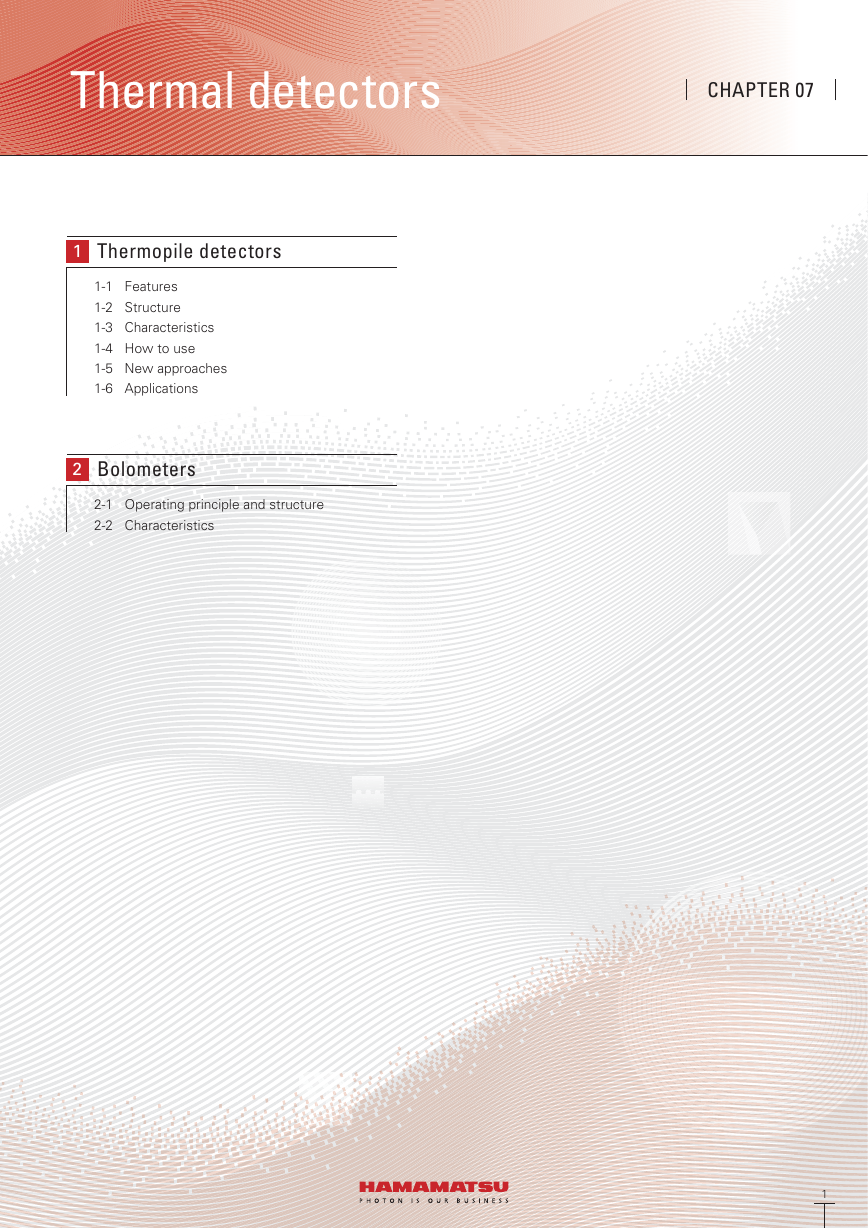
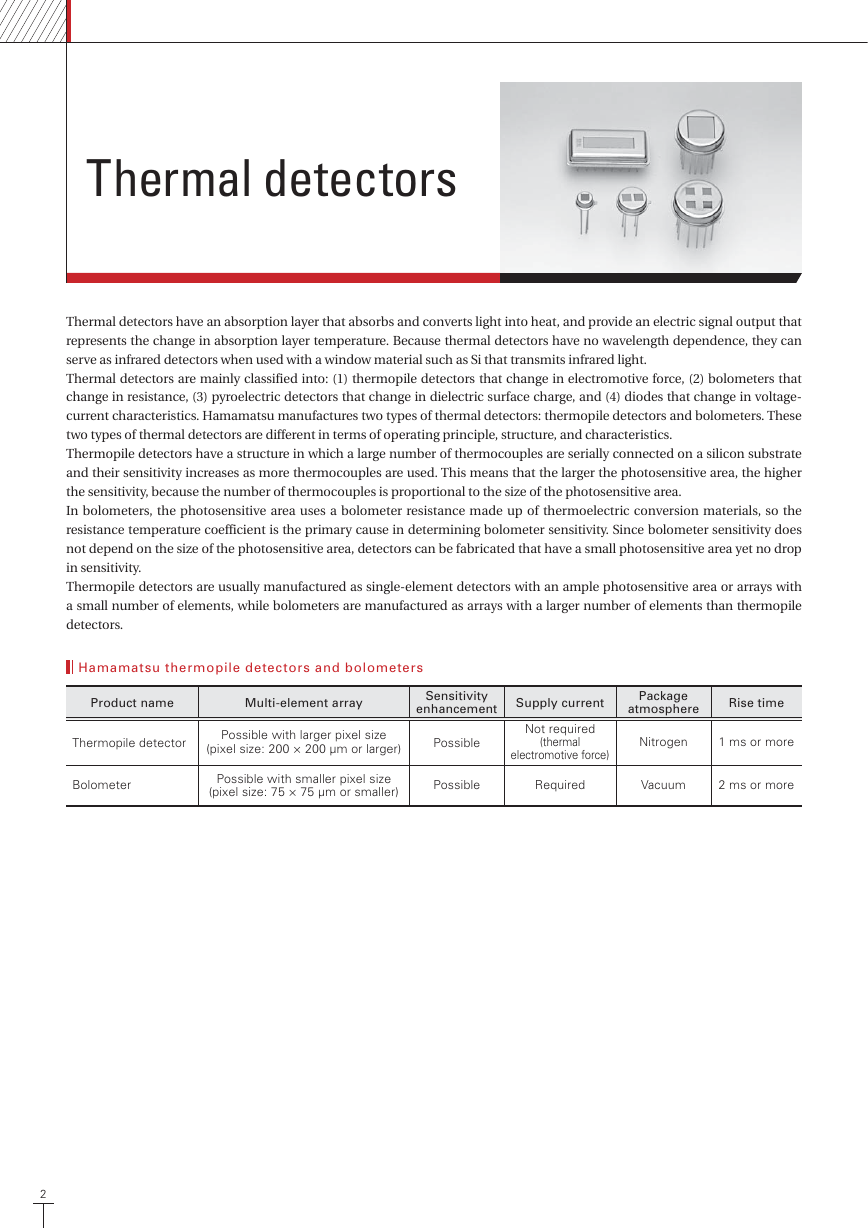
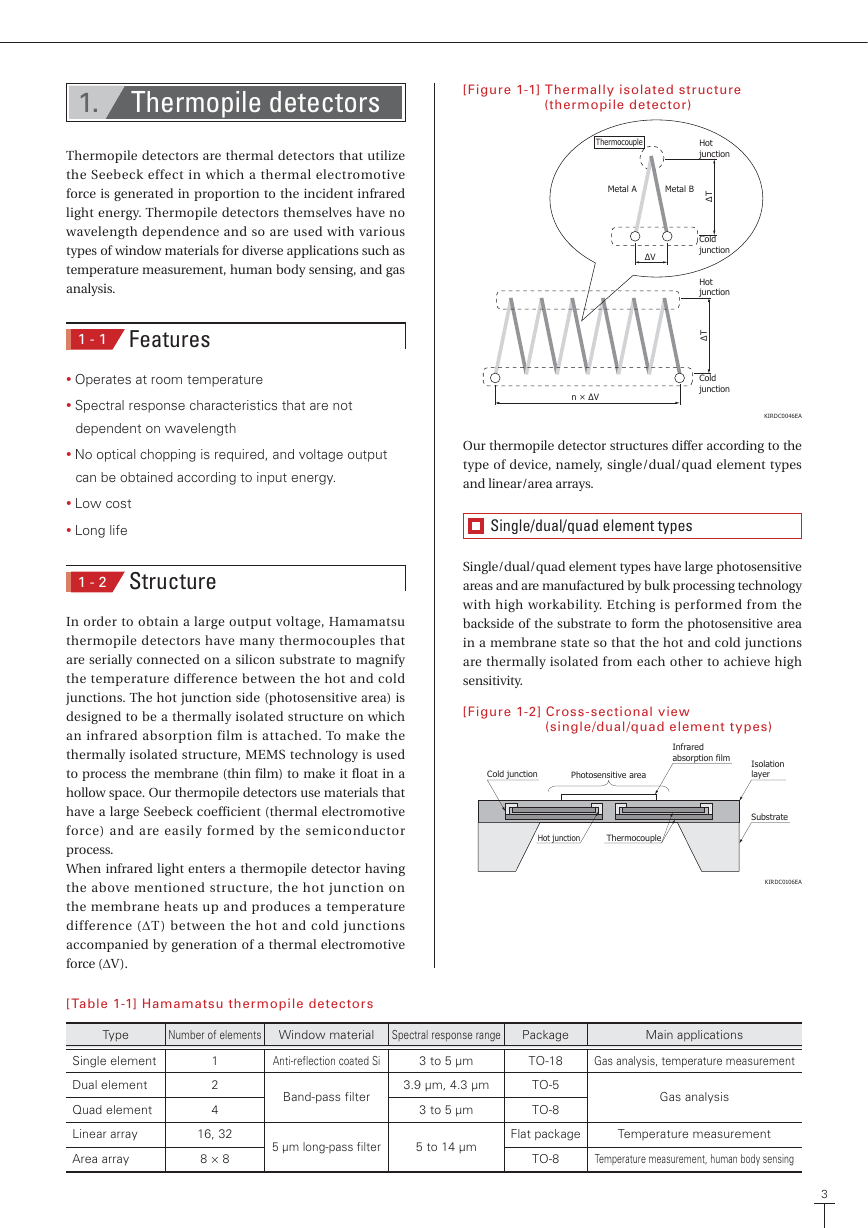
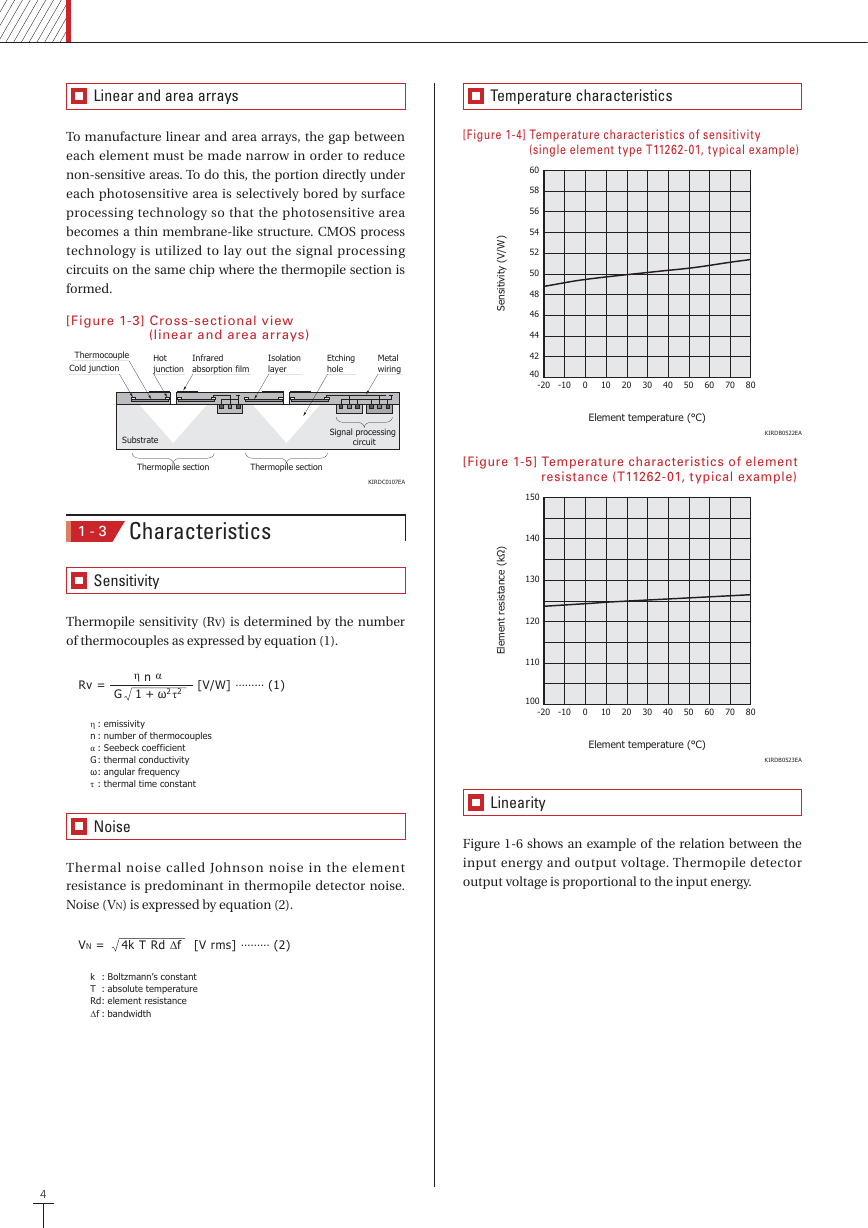
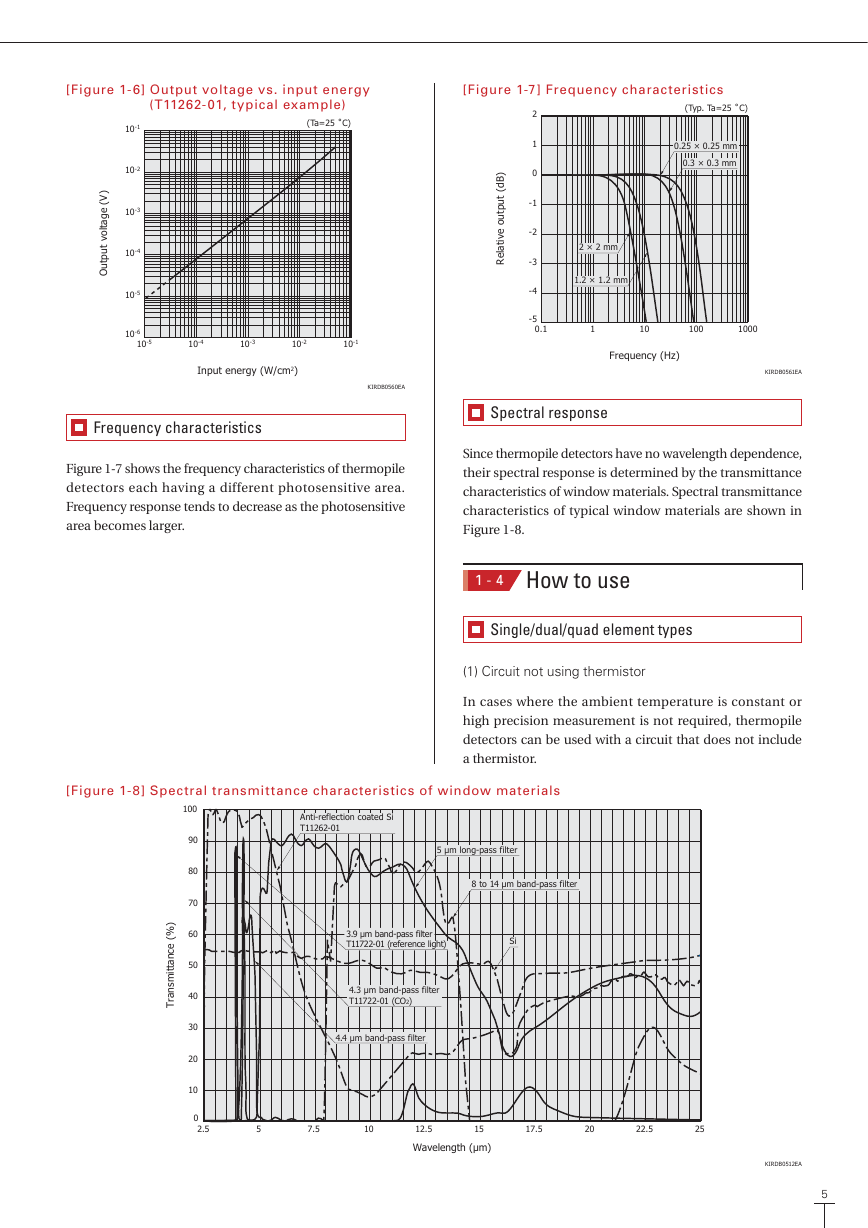
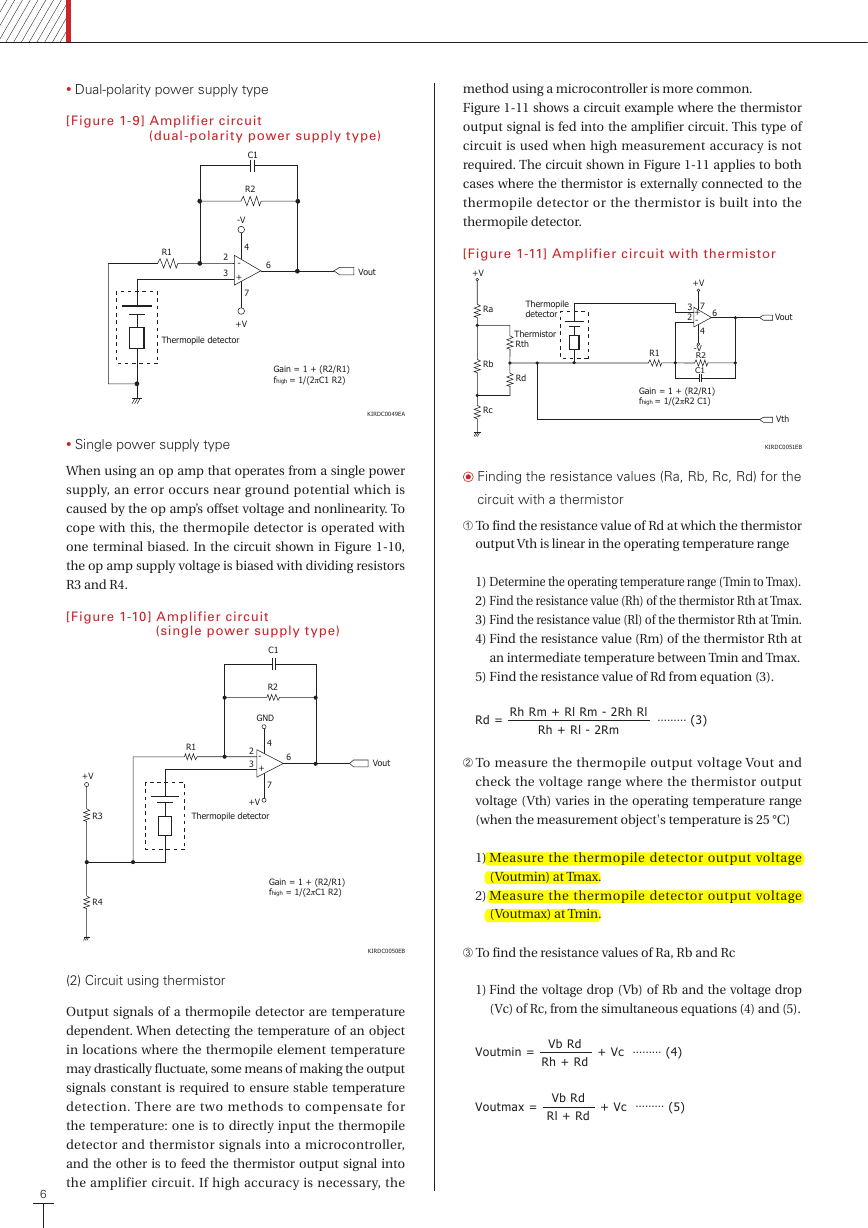
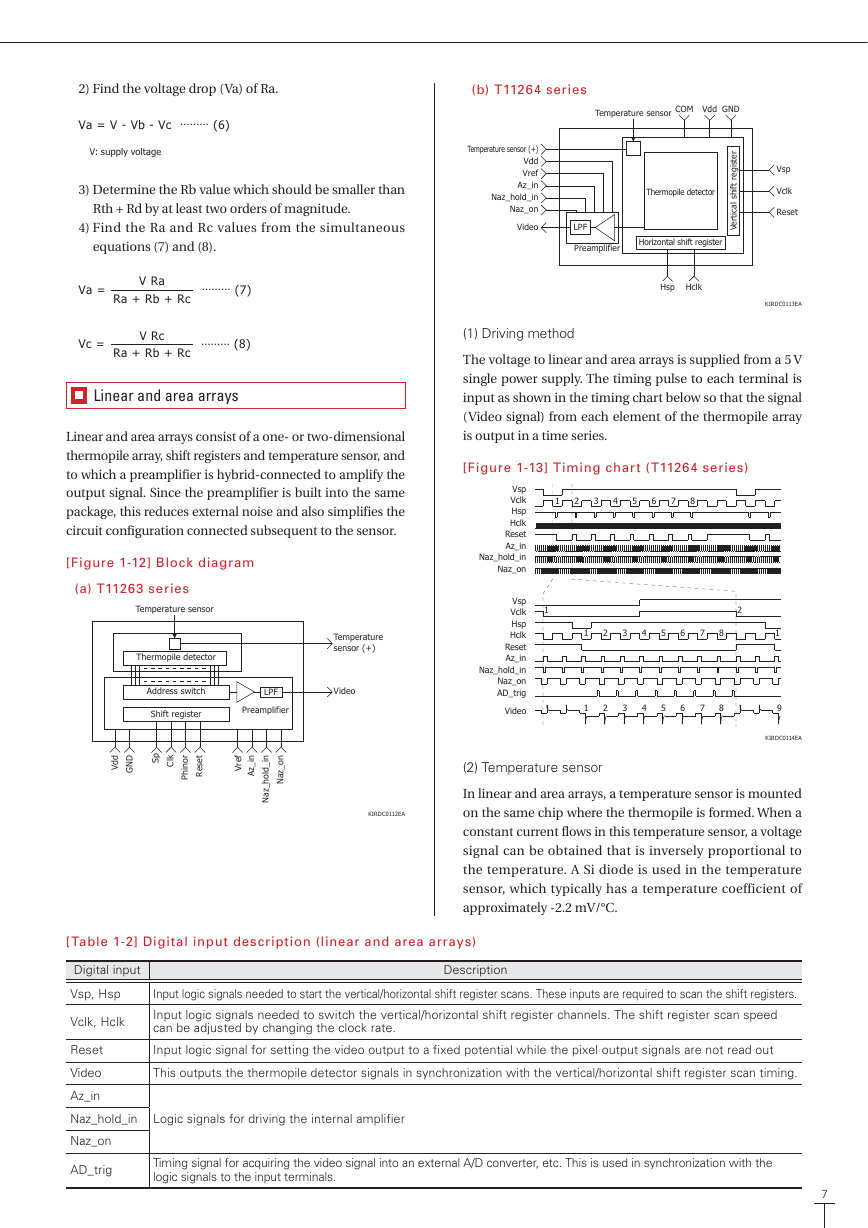
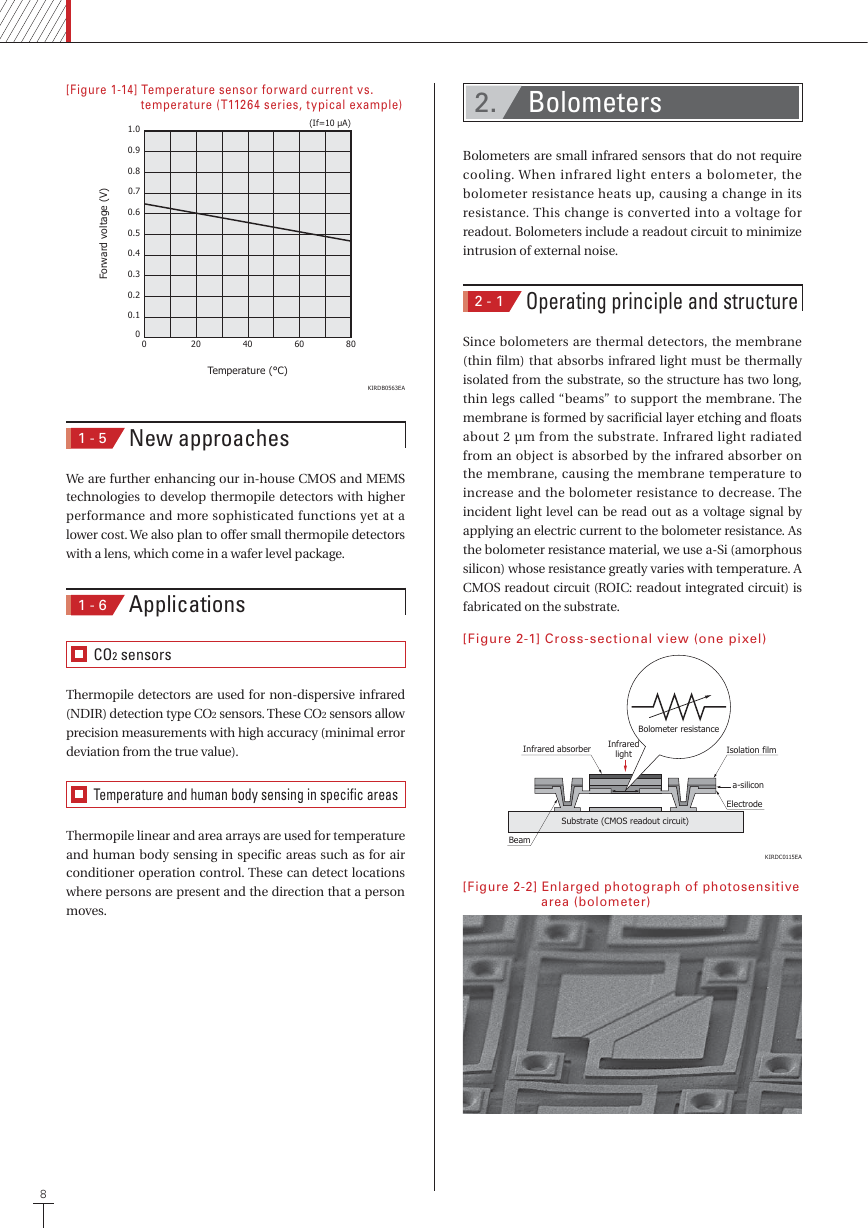








 2023年江西萍乡中考道德与法治真题及答案.doc
2023年江西萍乡中考道德与法治真题及答案.doc 2012年重庆南川中考生物真题及答案.doc
2012年重庆南川中考生物真题及答案.doc 2013年江西师范大学地理学综合及文艺理论基础考研真题.doc
2013年江西师范大学地理学综合及文艺理论基础考研真题.doc 2020年四川甘孜小升初语文真题及答案I卷.doc
2020年四川甘孜小升初语文真题及答案I卷.doc 2020年注册岩土工程师专业基础考试真题及答案.doc
2020年注册岩土工程师专业基础考试真题及答案.doc 2023-2024学年福建省厦门市九年级上学期数学月考试题及答案.doc
2023-2024学年福建省厦门市九年级上学期数学月考试题及答案.doc 2021-2022学年辽宁省沈阳市大东区九年级上学期语文期末试题及答案.doc
2021-2022学年辽宁省沈阳市大东区九年级上学期语文期末试题及答案.doc 2022-2023学年北京东城区初三第一学期物理期末试卷及答案.doc
2022-2023学年北京东城区初三第一学期物理期末试卷及答案.doc 2018上半年江西教师资格初中地理学科知识与教学能力真题及答案.doc
2018上半年江西教师资格初中地理学科知识与教学能力真题及答案.doc 2012年河北国家公务员申论考试真题及答案-省级.doc
2012年河北国家公务员申论考试真题及答案-省级.doc 2020-2021学年江苏省扬州市江都区邵樊片九年级上学期数学第一次质量检测试题及答案.doc
2020-2021学年江苏省扬州市江都区邵樊片九年级上学期数学第一次质量检测试题及答案.doc 2022下半年黑龙江教师资格证中学综合素质真题及答案.doc
2022下半年黑龙江教师资格证中学综合素质真题及答案.doc